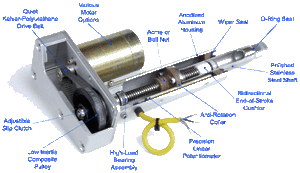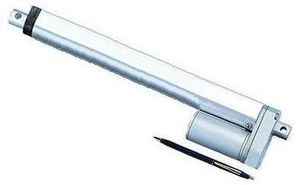Difference between revisions of "Linear Actuators"
m (moved Linear Actuator to Linear Actuators) |
|||
| Line 7: | Line 7: | ||
* Please start editing this page after the /noinclude | * Please start editing this page after the /noinclude | ||
* -------------------------------------------------></noinclude> | * -------------------------------------------------></noinclude> | ||
[[File:Linear actuators.gif|thumb|right|Linear Actuators]] | |||
[[File:Linear Actuator1.JPG|thumb|right|Linear Actuators]] | |||
'''Linear Actuators '''are [[Actuators]] that creates motion in a straight line, as contrasted with circular motion of a conventional electric motor. Linear actuators are used in machine tools and industrial machinery, in computer peripherals such as disk drives and printers, in valves and dampers, and in many other places where linear motion is required. [[Hydraulic Cylinders]] or [[Pneumatic Cylinders]] inherently produce linear motion; many other mechanisms are used to provide a linear motion from a rotating motor. | |||
==Types== | |||
===Mechanical actuators=== | |||
Mechanical linear actuators typically operate by conversion of rotary motion into linear motion. Conversion is commonly made via a few simple types of mechanism: | |||
* Screw: leadscrew, screw jack, ball screw and roller screw actuators all operate on the principle of the simple machine known as the screw. By rotating the actuator's nut, the screw shaft moves in a line. | |||
* Wheel and axle: Hoist, winch, rack and pinion, chain drive, belt drive, rigid chain and rigid belt actuators operate on the principle of the wheel and axle. A rotating wheel moves a cable, rack, chain or belt to produce linear motion. | |||
* Cam: Cam actuators function on a principle similar to that of the wedge, but provide relatively limited travel. As a wheel-like cam rotates, its eccentric shape provides thrust at the base of a shaft. | |||
Some mechanical linear actuators only pull, such as hoists, chain drive and belt drives. Others only push . Pneumatic and hydraulic cylinders, or lead screw can be designed to provide force in both directions. | |||
Mechanical actuators typically convert rotary motion of a control knob or handle into linear displacement via screws and/or gears to which the knob or handle is attached. A jackscrew or car jack is a familiar mechanical actuator. Another family of actuators are based on the segmented spindle. Rotation of the jack handle is converted mechanically into the linear motion of the jack head. Mechanical actuators are also frequently used in the field of lasers and optics to manipulate the position of linear stages, rotary stages, mirror mounts, gonio meters and other positioning instruments. For accurate and repeatable positioning, index marks may be used on control knobs. Some actuators even include an encoder and digital position readout.These are similar to the adjustment knobs used on micrometers except that their purpose is position adjustment rather than position measurement. | |||
===Hydraulic actuators=== | |||
Hydraulic actuators or hydraulic cylinders typically involve a hollow cylinder having a piston inserted in it. An unbalanced pressure applied to the piston provides force that can move an external object. Since liquids are nearly incompressible, a hydraulic cylinder can provide controlled precise linear displacement of the piston. The displacement is only along the axis of the piston. A familiar example of a manually operated hydraulic actuator is ahydraulic car jack. Typically though, the term hydraulic actuator refers to a device controlled by a hydraulic pump. | |||
===Pneumatic actuators=== | |||
Pneumatic actuators, or pneumatic cylinders, are similar to hydraulic actuators except they use compressed gas to provide pressure instead of a liquid. They work similarly to a piston in which air is input inside of a chamber and pushes air out of the other side of the chamber. Air actuators are not necessarily used for heavy duty machinery and instances where large amounts of weight are present. One of the reasons that pneumatic linear actuators are preferred to other types is the fact that the power source is simply a compressed air machine. Because air is the input source, pneumatic actuators are able to be used in many places of mechanical activity. The downside is that most air compressors are large, bulky, and loud. They are hard to transport to other areas once installed. Also, pneumatic linear actuators are likely to leak and this makes them less efficient than mechanical linear actuators. | |||
===Piezoelectric actuators=== | |||
The piezoelectric effect is a property of certain materials in which application of a voltage to the material causes it to expand. Very high voltages correspond to only tiny expansions. As a result, piezoelectric actuators can achieve extremely fine positioning resolution, but also have a very short range of motion. In addition, piezoelectric materials exhibit hysteresis which makes it difficult to control their expansion in a repeatable manner. | |||
===Electro-mechanical actuators=== | |||
A miniature electro-mechanical linear actuator where the lead nut is part of the motor. The lead screw does not rotate, so as the lead nut is rotated by the motor, the lead screw is extended or retracted. Electro-mechanical actuators are similar to mechanical actuators except that the control knob or handle is replaced with an electric motor. Rotary motion of the motor is converted to linear displacement of the actuator. There are many designs of modern linear actuators and every company that manufactures them tends to have their own proprietary method. | |||
Revision as of 06:12, 5 December 2012
Linear Actuators are Actuators that creates motion in a straight line, as contrasted with circular motion of a conventional electric motor. Linear actuators are used in machine tools and industrial machinery, in computer peripherals such as disk drives and printers, in valves and dampers, and in many other places where linear motion is required. Hydraulic Cylinders or Pneumatic Cylinders inherently produce linear motion; many other mechanisms are used to provide a linear motion from a rotating motor.
Types
Mechanical actuators
Mechanical linear actuators typically operate by conversion of rotary motion into linear motion. Conversion is commonly made via a few simple types of mechanism:
- Screw: leadscrew, screw jack, ball screw and roller screw actuators all operate on the principle of the simple machine known as the screw. By rotating the actuator's nut, the screw shaft moves in a line.
- Wheel and axle: Hoist, winch, rack and pinion, chain drive, belt drive, rigid chain and rigid belt actuators operate on the principle of the wheel and axle. A rotating wheel moves a cable, rack, chain or belt to produce linear motion.
- Cam: Cam actuators function on a principle similar to that of the wedge, but provide relatively limited travel. As a wheel-like cam rotates, its eccentric shape provides thrust at the base of a shaft.
Some mechanical linear actuators only pull, such as hoists, chain drive and belt drives. Others only push . Pneumatic and hydraulic cylinders, or lead screw can be designed to provide force in both directions.
Mechanical actuators typically convert rotary motion of a control knob or handle into linear displacement via screws and/or gears to which the knob or handle is attached. A jackscrew or car jack is a familiar mechanical actuator. Another family of actuators are based on the segmented spindle. Rotation of the jack handle is converted mechanically into the linear motion of the jack head. Mechanical actuators are also frequently used in the field of lasers and optics to manipulate the position of linear stages, rotary stages, mirror mounts, gonio meters and other positioning instruments. For accurate and repeatable positioning, index marks may be used on control knobs. Some actuators even include an encoder and digital position readout.These are similar to the adjustment knobs used on micrometers except that their purpose is position adjustment rather than position measurement.
Hydraulic actuators
Hydraulic actuators or hydraulic cylinders typically involve a hollow cylinder having a piston inserted in it. An unbalanced pressure applied to the piston provides force that can move an external object. Since liquids are nearly incompressible, a hydraulic cylinder can provide controlled precise linear displacement of the piston. The displacement is only along the axis of the piston. A familiar example of a manually operated hydraulic actuator is ahydraulic car jack. Typically though, the term hydraulic actuator refers to a device controlled by a hydraulic pump.
Pneumatic actuators
Pneumatic actuators, or pneumatic cylinders, are similar to hydraulic actuators except they use compressed gas to provide pressure instead of a liquid. They work similarly to a piston in which air is input inside of a chamber and pushes air out of the other side of the chamber. Air actuators are not necessarily used for heavy duty machinery and instances where large amounts of weight are present. One of the reasons that pneumatic linear actuators are preferred to other types is the fact that the power source is simply a compressed air machine. Because air is the input source, pneumatic actuators are able to be used in many places of mechanical activity. The downside is that most air compressors are large, bulky, and loud. They are hard to transport to other areas once installed. Also, pneumatic linear actuators are likely to leak and this makes them less efficient than mechanical linear actuators.
Piezoelectric actuators
The piezoelectric effect is a property of certain materials in which application of a voltage to the material causes it to expand. Very high voltages correspond to only tiny expansions. As a result, piezoelectric actuators can achieve extremely fine positioning resolution, but also have a very short range of motion. In addition, piezoelectric materials exhibit hysteresis which makes it difficult to control their expansion in a repeatable manner.
Electro-mechanical actuators
A miniature electro-mechanical linear actuator where the lead nut is part of the motor. The lead screw does not rotate, so as the lead nut is rotated by the motor, the lead screw is extended or retracted. Electro-mechanical actuators are similar to mechanical actuators except that the control knob or handle is replaced with an electric motor. Rotary motion of the motor is converted to linear displacement of the actuator. There are many designs of modern linear actuators and every company that manufactures them tends to have their own proprietary method.

